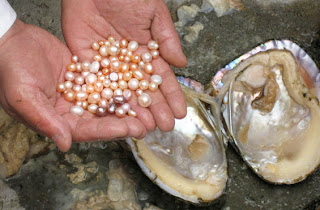Of Great Price: Facts and Folklore of Pearls

According to the American Gem Trade Association, June is one of two months in the calendar to have three birthstones: pearl, moonstone, and alexandrite. Throughout history the pearl has been a much sought-after ornament, difficult to obtain and all the more prized for its rarity before cultured pearls became more readily available.
Pearls generally appear in lists of precious gemstones but they are not a stone; they are formed in the bodies of mollusks such as oysters and clams in response to irritants such as grains of sand. The largest pearl on record, known as the Pearl of Lao Tzu, came from a giant clam and weighed slightly over fourteen pounds.
Chinese mythology attributes the glow of pearls to the influence of the moon and claims that pearls fall to earth when dragons fight in the heavens.
Ground pearls were sometimes used in medicines for insanity---or “lunacy,” because of the pearl’s supposed connection with the moon.
In Greek legends, pearls were the tears of gods and goddesses or the drops of water shed by Aphrodite, goddess of love, when she emerged from the sea. They were a protective influence against grief and were an appropriate wedding gift that would promote a happy marriage. But some superstitions take the darker view that since pearls are symbolic of tears, every pearl worn by a bride will mean an occasion for weeping in her married life. L.M. Montgomery gives the nod to this belief when her heroine, Anne Shirley, chooses pearls for her engagement ring in the novel Anne’s House of Dreams:
"But pearls are for tears, the old legend says," Gilbert had objected.
"I'm not afraid of that. And tears can be happy as well as sad. My very happiest moments have been when I had tears in my eyes—when Marilla told me I might stay at Green Gables—when Matthew gave me the first pretty dress I ever had—when I heard that you were going to recover from the fever. So give me pearls for our troth ring, Gilbert, and I'll willingly accept the sorrow of life with its joy."
The classic color most often associated with pearls is a soft creamy white, but pearls can appear in a rainbow of shades ranging from pale yellow and pink to gray and black. The practice of growing cultured pearls, in which a grain of sand or other irritant is deliberately seeded in an oyster, has made pearls of all colors more widely available at somewhat lower prices than natural pearls. Cultured pearls can also be dyed or bleached to achieve desirable colors.
In one of the parables from the Gospel of Matthew, Christ compares the kingdom of Heaven to “a pearl of great price.” Elsewhere in the Bible, Christ warns his listeners, “cast not thy pearls before swine,” and the Revelation of John describes the gates of Heaven as each being made from one large pearl.
Because pearls are made of organic substances and not stone, they can be damaged by perfume, cleansers, lotions, and perspiration, as well as by chlorinated water in swimming pools, ammonia, or even long exposure to bright sunlight.
So whether or not you are a June baby, whether your style leans more toward classic string or funky ring, enjoy your pearls and wear them in good health all through the year.
Pearls: A Natural History
American Gem Trade Association
World Record Gems
Mikimoto Pearls
Pearls: A Natural History
American Gem Trade Association
World Record Gems
Mikimoto Pearls
Comments